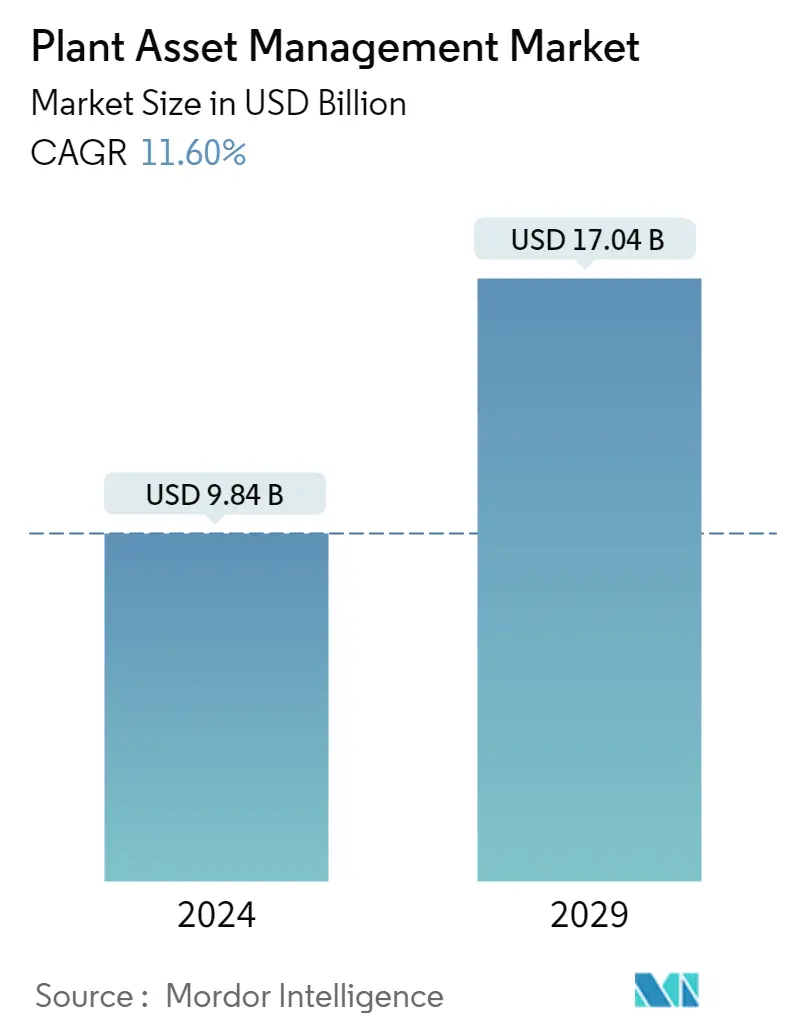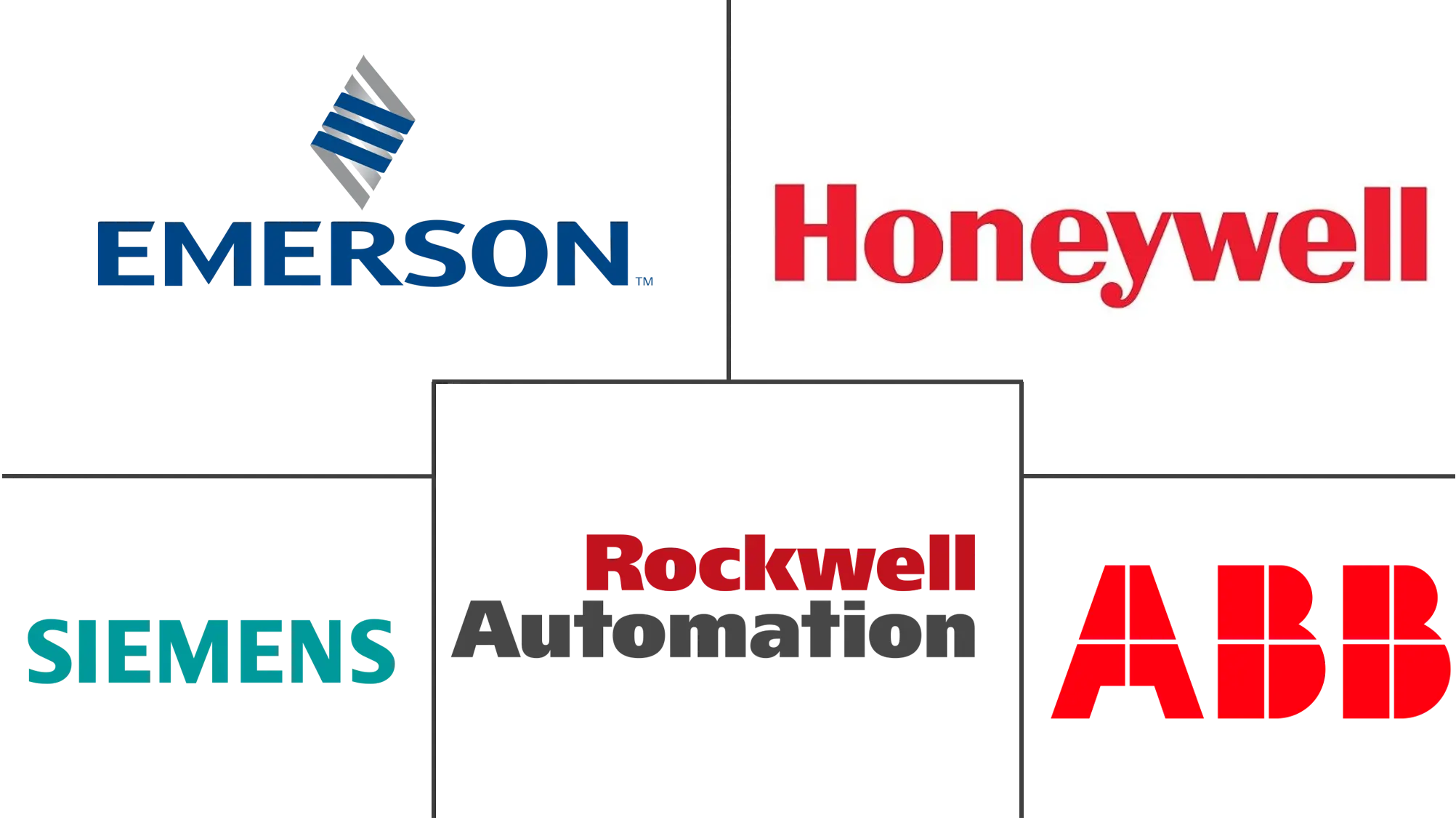Market Size of Plant Asset Management Industry

| Study Period | 2019 - 2029 |
| Market Size (2024) | USD 9.84 Billion |
| Market Size (2029) | USD 17.04 Billion |
| CAGR (2024 - 2029) | 11.60 % |
| Fastest Growing Market | Asia Pacific |
| Largest Market | North America |
Major Players
*Disclaimer: Major Players sorted in no particular order |
Plant Asset Management Market Analysis
The Plant Asset Management Market size is estimated at USD 9.84 billion in 2024, and is expected to reach USD 17.04 billion by 2029, growing at a CAGR of 11.60% during the forecast period (2024-2029).
Using plant-based asset management systems, manufacturing firms may conduct routine equipment inspections to reduce the likelihood of failures. A plant asset management system enables companies to track every location where machines are being used. Field technicians can regulate equipment usage and ensure it stays with the authorized employees using real-time location tracking. The ability to track locations also ensures the equipment is handled within the plant's safety guidelines for production.
Advantage Automotive Analytics launched Revo Asset Management, a platform for innovative location-based technology. The application will track, monitor and locate valuable assets in real-time. The application safeguards construction equipment, generators, and other valuables with low-cost, smart GPS technology.
Sudden equipment downtime can affect production schedules, which can delay order fulfillment, lead to unhappy customers, and result in income loss. Recognizing this challenge, Aptean introduced a cloud-based enterprise asset management solution (EAM) to handle work orders, automate approvals, track spare parts inventories, schedule preventative maintenance, allocate appropriately skilled workers, and conduct mobile compliance inspections. CoreFx, the early adopters of Aptean EAM, observed a reduction in overall accidents leading to less downtime on the floor.
If a company keeps assets of the warranty status or avail assets, it could save the business real money by paying for unnecessary repairs. According to ServiceChannel research, firms lose almost 35% of potential warranty savings from paying for repair on under-warranty equipment. Such defaults can be managed with the help of Asset management software.
Data Security can affect the growth of the Plant Asset Management Market. Cloud facilities are a great way to store enormous amounts of data, but if managed well, it is safe from theft. The company can not only suffer financial loss, but a negative reputation can also damage a company's profile.
With lockdowns around the globe, most industries suffered a loss of revenue during the COVID-19 outbreak. One such sector was the construction business, where companies were hit hard because the industry needed to be data-driven. Some companies recognized this challenge and adopted asset management software like Go Codes tool tracking software. The app listed all the information about company assets for better productivity. For instance, a technician could check equipment availability in real time by checking in the app.
Plant Asset Management Industry Segmentation
Asset management for manufacturing companies deals with the entire lifecycle of plant assets, including making decisions about asset use, asset investment and disinvestment policies, and managing the asset portfolio. All manufacturing sections, like equipment, parts, production lines, and plant buildings, are handled during asset management. The application of Plant Asset Management can help plants to refine maintenance scheduling to cut maintenance costs, track and manage inventory and equipment usage, adapt to labor shortages and a lack of technical skills, and much more. As the world moves towards digitalization, a manufacturing company uses Plant Asset Management software and hardware services to monitor assets over their lifecycle.
The plant asset management market is segmented by offerings (software, services), deployment (on-premise, cloud), end-user (energy and power, oil & gas, petrochemical, mining & metal, aerospace & defense, Automotive), and geography (North America, Europe, Asia Pacific, Latin America, Middle East & Africa).
The market sizes and forecasts are provided in terms of value (USD).
| Offerings | |
| Software | |
| Services |
| Deployment | |
| On-Premise | |
| Cloud |
| End-User | |
| Energy and Power | |
| Oil & Gas | |
| Petrochemical | |
| Mining & Metal | |
| Aerospace & Defense | |
| Automotive | |
| Other End-Users |
| Geography | |
| North America | |
| Europe | |
| Asia-Pacific | |
| Latin America | |
| Middle-East and Africa |
Plant Asset Management Market Size Summary
The Plant Asset Management market is poised for significant growth, driven by the increasing need for efficient equipment tracking and maintenance solutions across various industries. These systems enable manufacturing firms to conduct routine inspections, reducing the likelihood of equipment failures and ensuring compliance with safety guidelines. The adoption of cloud-based enterprise asset management solutions is on the rise, offering features such as work order management, preventative maintenance scheduling, and real-time location tracking. This trend is particularly evident in sectors like oil and gas, where the complexity and cost of operations necessitate advanced asset management strategies to minimize downtime and optimize maintenance planning. The integration of predictive analytics and machine learning further enhances these systems, allowing companies to forecast maintenance needs and reduce operational expenses.
The market is characterized by intense competition, with major players like ABB Group, Emerson Electric Co., Siemens AG, Rockwell Automation, and Honeywell International leading the charge. These companies are investing heavily in artificial intelligence and cloud technologies to enhance their asset management offerings. Recent collaborations and technological advancements, such as Honeywell's carbon emissions monitoring solution and Arcadis's predictive maintenance technologies, underscore the industry's focus on sustainability and efficiency. The COVID-19 pandemic has accelerated the adoption of asset management software, as companies seek to improve productivity and reduce costs in a challenging economic environment. As industries continue to recover and evolve, the demand for robust plant asset management solutions is expected to grow, driven by the need for improved asset utilization and cost-effective maintenance strategies.
Plant Asset Management Market Size - Table of Contents
-
1. MARKET DYNAMICS
-
1.1 Market Overview
-
1.2 Market Drivers
-
1.2.1 Adoption Of Real-Time Data Analytics
-
1.2.2 Adoption of Lean Manufacturing Practices
-
-
1.3 Market Restraints
-
1.3.1 Lack of Skilled Personnel
-
-
1.4 Industry Value Chain Analysis
-
1.5 Industry Attractiveness - Porter's Five Forces Analysis
-
1.5.1 Threat of New Entrants
-
1.5.2 Bargaining Power of Buyers/Consumers
-
1.5.3 Bargaining Power of Suppliers
-
1.5.4 Threat of Substitute Products
-
1.5.5 Intensity of Competitive Rivalry
-
-
-
2. MARKET SEGMENTATION
-
2.1 Offerings
-
2.1.1 Software
-
2.1.2 Services
-
-
2.2 Deployment
-
2.2.1 On-Premise
-
2.2.2 Cloud
-
-
2.3 End-User
-
2.3.1 Energy and Power
-
2.3.2 Oil & Gas
-
2.3.3 Petrochemical
-
2.3.4 Mining & Metal
-
2.3.5 Aerospace & Defense
-
2.3.6 Automotive
-
2.3.7 Other End-Users
-
-
2.4 Geography
-
2.4.1 North America
-
2.4.2 Europe
-
2.4.3 Asia-Pacific
-
2.4.4 Latin America
-
2.4.5 Middle-East and Africa
-
-
Plant Asset Management Market Size FAQs
How big is the Plant Asset Management Market?
The Plant Asset Management Market size is expected to reach USD 9.84 billion in 2024 and grow at a CAGR of 11.60% to reach USD 17.04 billion by 2029.
What is the current Plant Asset Management Market size?
In 2024, the Plant Asset Management Market size is expected to reach USD 9.84 billion.

